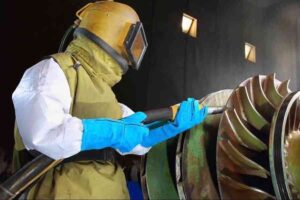Sandblasting is a widely used surface preparation technique that’s most commonly associated with metal and glass surfaces. It has a wide range of applications, including in restoration projects.
Sandblasting furniture can achieve impressive results but needs to be carefully managed by a skilled operator. Careful consideration needs to be taken to ensure that wood or other furniture materials are not damaged by the sandblasting process.
What furniture materials can be sandblasted and what should be considered before beginning the sandblasting process?
Can you use sandblast furniture?
While sandblasting is commonly associated with industrial applications, such as the preparation of metals, it can also be used in furniture restoration and refinishing. It involves propelling abrasive materials at high speed at the surface of the furniture to remove paints, treatments and other imperfections.
Sandblasting furniture requires careful preparation and administration to ensure that the process doesn’t damage the wood or other materials. Not all furniture will be suitable for sandblasting and a thorough inspection by an experienced operator should be conducted before deciding to use the technique.
Can cabinets be sandblasted?
Sandblasting cabinets and other furniture depend to a large extent on the materials they are made of. Hardwood furniture, such as cabinets built from oak, mahogany, or walnut are generally better able to withstand the abrasive force of sandblaster than softer woods such as pine. Veneers do not generally respond well to the sandblasting process due to the thin surface layer. Sandblasting can easily strip away the veneer resulting in significant harm to the appearance and structural integrity of the cabinet.
The cabinet should be inspected for any existing damage or weak spots and thoroughly cleaned. Skilled operators in sandblasting furniture should handle the process to ensure that the right pressure and abrasive materials are selected to achieve the desired results without causing harm to the cabinet.
How much does it cost to sandblast furniture?
The cost of sandblasting furniture can vary significantly depending on a range of factors, such as the size, type, and overall condition of the piece. Larger and more intricately designed pieces of furniture are likely to incur higher costs due to the increased time and effort required to achieve the desired results.
Smaller pieces such as chairs or side tables will be cheaper to sandblast than larger furniture such as wardrobes or dining tables. While DIY methods will be cheaper these are generally best avoided due to the risk of permanent damage being caused to the furniture. Professional furniture sandblasting services ensure expert handling and high-quality results.
Professional furniture sandblasting from Pershore Dip Coating
The professional and experienced team at Pershore Dip Coating are skilled at sandblasting furniture for both commercial and residential customers.
Our sandblasting service in Worcester is a budget-friendly and highly effective means to achieve the desired results.
Our family-run team provides a personal and professional approach to all our clients across all our services. We pride ourselves on the quality of our work and can offer expert advice about the shot blasting process.
Contact us to find out more and to request a comprehensive quote.




